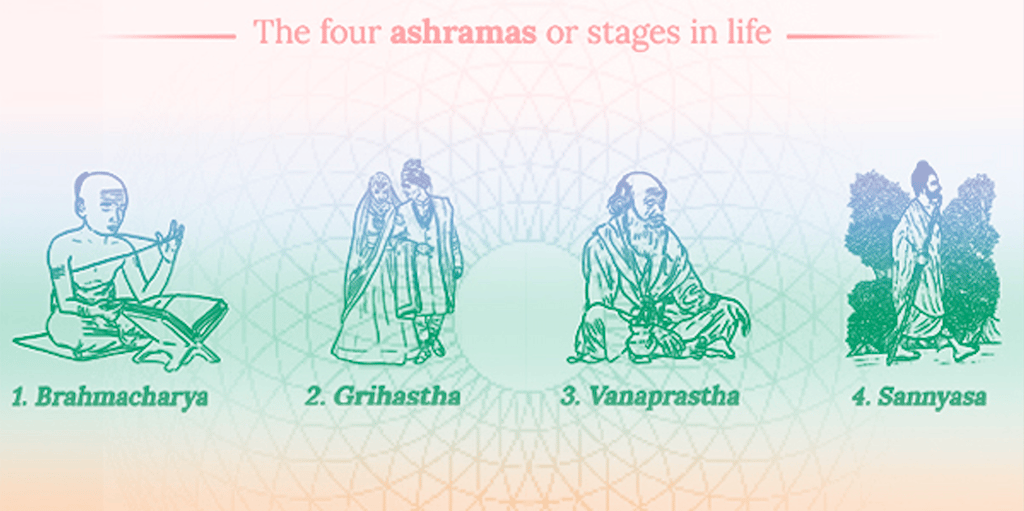The Four Aashrams of Hinduism: A Blueprint for Life
Discover the Four Aashrams (Stages) of Life—Brahmacharya, Grihasth, Vanaprasth, and Sannyas—an ancient Vedic framework. Rooted in Dharma, this journey help individuals live a balanced, purposeful, and spiritually fulfilling life in modern times.
3 min read


आहार निद्रा भय मैथुनं च सामान्यमेतत् पशुभिर्नराणाम् | धर्मो हि तेषामधिको विशेषो धर्मेण हीनाः पशुभिः समानाः ||
Eating, sleeping, fearing, and mating are common between animals and humans. What sets humans apart is dharma. Without dharma, humans are no better than animals.
To live just by instinct—eating, sleeping, mating, and fearing—is to live like any other animal. What elevates us is Dharma, a sense of duty and morality. Our ancient rishis understood that without a structured path, the mind can get lost in either indulgence, confusion or anxiety. That’s why they gave us the framework of the Four Aashrams: Brahmacharya, Grihasth, Vanaprasth, and Sannyas. Each stage offers growth, balance, pleasure, reflection, renunciation and ultimately, spiritual realisation.
1. Brahmacharya Aashram (The Student Stage)
This foundational phase of life traditionally begins around the age of 8-12 and extends up to 25. Brahmacharya is dedicated to devotion, learning, self-discipline, focus and celibacy. In ancient times students would live with a guru (in the gurukul system) and study the Vedas, Upanishads, logic, philosophy, and practical skills for life. This stage lays the groundwork for one’s character and future. It is about shaping the mind and instilling values that support both worldly and spiritual success.
In today’s age, Brahmacharya is about cultivating focus amidst distractions, and understanding the importance of restraint in a world of instant gratification. My guru says that if a person doesn’t learn to handle kaam (desires) in their youth, they will struggle to renounce bhog (pleasures like lust, rich food, alcohol, and indulgences) in old age. The stage of Brahmacharya trains young minds to channel that powerful energy toward something higher—like material growth, spiritual growth or even an enlightenment. It is during this aashram that sanskars (impressions/values) are formed.
2. Grihasth Aashram (The Householder Stage)
Once the foundation of discipline and values is built during Brahmacharya, the individual is ready to step into the next phase—Grihasth Aashram. From around 25 to 50 years of age, the individual enters the Grihasth phase. Here, one pursues a career, marries, raises a family and contributes to society. In this aashram, husband and wife are expected to uphold dharma, balance living, practise charity, and walk the spiritual path— while enjoying worldly pleasures (bhog). If Brahmacharya Aashram was followed with discipline, the bond between husband and wife naturally deepens in this stage. Such a couple is more likely to raise children with sharpened intellect and wisdom from an early age. This is the most active and socially engaged stage of life. It's a beautiful aashram where a husband and wife both share each other's achievements, happiness, sorrows, grief and challenges. It also shows that spiritual growth is possible without renouncing worldly life.
3. Vanaprasth Aashram (The Hermit/Retirement Stage)
After fulfilling responsibilities as a householder, the individual gradually withdraws from worldly involvement. This transition leads into Vanaprasth Aashram (meaning going to the forest), a time of reflection, pilgrimage and develop spiritual maturity. It typically begins around the age of 50-55. As one becomes a parent and worldly duties lessen, the shift towards detachment begins in this Aashram. It is not possible to retreat to the forest like ancients used to do. Modern Vanprashthis are encouraged to live a simpler life while staying with their kids, focus more on spirituality, perform penance through vrat, sadhana or tapasya, and gradually reduce their bhog-vritti (tendencies toward indulgence, rich food, and sensual pleasures). They are also meant to guide the younger generation, sharing the importance of the Brahmacharya Aashram and life lessons drawn from their own experience. This stage encourages one to let go of desires and prepare the mind for Sannyas Aashram.
4. Sannyas Aashram (The Renunciate Stage)
As detachment deepens and the pull of desires weakens, the final stage begins—Sannyas Aashram. This stage is about completely letting go of material life. The individual gives up possessions and social obligations to focus solely on liberation (moksha). This stage involves spending majority of the time in spirituality and complete devotion to God. It allows the seeker to break free from all bonds and merge with the Divine. Sannyasi (one who follows this path) is an inspiration for others when it comes to renunciation. In ancient times, people would often go to forests or sacred cities known as the Sapta Mokshapuris to seek liberation. These seven holy places are Ayodhya, Mathura, Haridwar, Kashi (Varanasi), Kanchi, Ujjain, and Dwarka. But in today’s world, it may not be practical. Still, one can follow the spirit of Sannyas by living simply, serving others, meditating, and staying completely devoted to God.
Conclusion
The Four Aashrams are not just stages of age, but a conscious journey from discipline to liberation. At every stage, dharma remains the constant thread—guiding our actions, choices, and responsibilities. During Grihasth Aashram, the pursuit of artha (material well-being) and kaam (desires) is considered not only acceptable but necessary, as long as it is balanced by dharma. As one transitions into Vanaprasth and Sannyas, the focus naturally shifts from outward to inward.